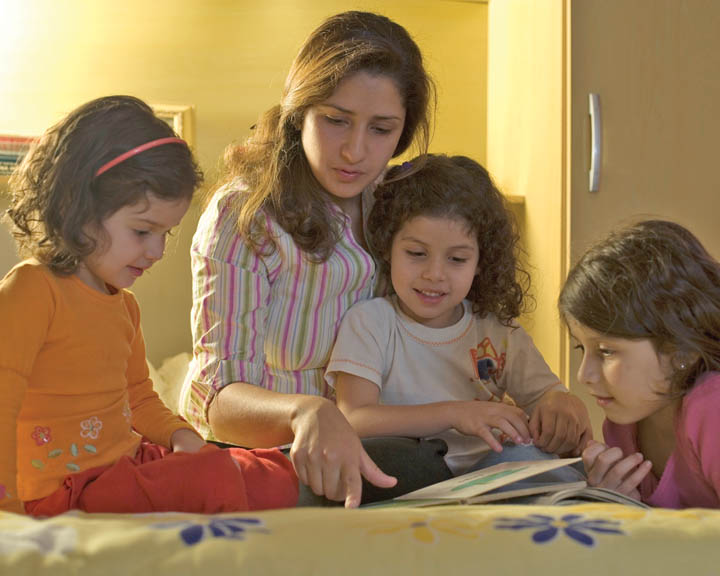Parents have the most influence over children when they are young and so religious education must begin in childhood. While church can be a valuable tool for parents, it is less likely to influence a child’s entire life if it is the only religious influence. It is essential that parents think of church as a support to their own religious training, not as a replacement for parental training.
 The best way to teach children about Jesus Christ is to make it an ordinary part of every day. Story times should include stories about Jesus Christ. Parents should, of course, make sure children know these stories are true. Family discussions should naturally include references to the Savior. Family activities can center around things Jesus has asked us to do and children should know that is why they are doing them.
The best way to teach children about Jesus Christ is to make it an ordinary part of every day. Story times should include stories about Jesus Christ. Parents should, of course, make sure children know these stories are true. Family discussions should naturally include references to the Savior. Family activities can center around things Jesus has asked us to do and children should know that is why they are doing them.
Family prayer and family scripture study are indispensible to a family’s religious education. Begin and end each day with a family prayer and encourage your children to pray privately as well. Make family scripture study a part of the morning routine, even if it means getting up a half hour earlier. Let family members take turns reading a verse or two. If children are young, follow up the reading from the family Bible with the same story in a children’s Bible.
Children respond so well to stories. Tell them the stories of Jesus on a regular basis. Have the children tell them using homemade flannel boards and stick puppets. When they tell the stories, they remember them so much better. Once a week, have a scripture story family activity, perhaps on Sunday evenings. Let each child and adult tell a favorite Bible story in any way he chooses—words, pictures, puppets, or flannel. The time the children spend preparing will help them learn the story.
In religion classes, children often learn a Bible story and then do activities that revolve around the story. This reinforces the story and helps the children learn to apply the message to their own lives. You can use this technique in your own home. Consider having a story or scripture of the week. If you choose a scripture, post it somewhere it will be easily seen. Help the children memorize it and make sure they know what it means. Then think of activities that will reinforce the lessons about Jesus the scripture or story teaches.
If you’re not sure how to do this, find out if your church has a lesson manual for the teachers of the children at church. This manual can give you ideas. Here are some techniques found in a manual about the New Testament. It is the teacher’s manual for children ages four to seven who attend The Church of Jesus Christ of Latter-day Saints. You have probably heard its members referred to by the nickname Mormons.
The lesson can be read here:
As you read the lesson, notice the ways the teacher is encouraged to reinforce the message. The Bible story being taught is that of the Ten Lepers. Jesus healed them but only one stayed behind to thank Jesus for His service to them. The message, of course, is that we need to thank God for our blessings.
The teacher doesn’t actually start with the story. She starts with the theme. This way, when the children hear the story, they will notice the message right away. Some of the methods used to help children learn the story and the lesson are:
An activity that helps the children start to name the blessings they have received from God. (They can’t thank God until they know what He has done for them.)
Stories about ordinary children that require students to solve problems and to apply the message.
Beginning with the tangible, secular concept, which is easier for children to understand—they learn about a child thanking a grandparent first. Then they move to learning to thank God.
Hearing the Bible story told, having it explained to them, and learning what the message is.
Reading a related scripture so they know the message is repeated in other parts of the Bible
Singing a song about prayer, since that is how they will thank God, and then talking about prayer.
Learning how to apply the message by deciding how modern children in mini-stories should show gratitude.
Drawing pictures of things they are thankful for.
Tying the lesson to the creation and learning to be thankful for it.
You don’t, of course, need to teach a formal lesson. You can simply incorporate ideas like this into your week. For instance, you might tell the story on Sunday and then have the children write thank you letters to someone. On Monday, you might ask your children to draw pictures of their blessings. On Tuesday, you could read about the creation for scripture study and tie it back to Sunday’s story. On Wednesday, you could teach some songs. Each day, do a little activity that reinforces Sunday’s story and continue to talk about the story. By the end of the week, the children remember the story and the related teachings.
It is important, as you model a Christian lifestyle for your children, that they understand that it is Jesus who is your model. They need to know why you choose to live your life according to His teachings and to be guided to wanting to make those choices for themselves.
